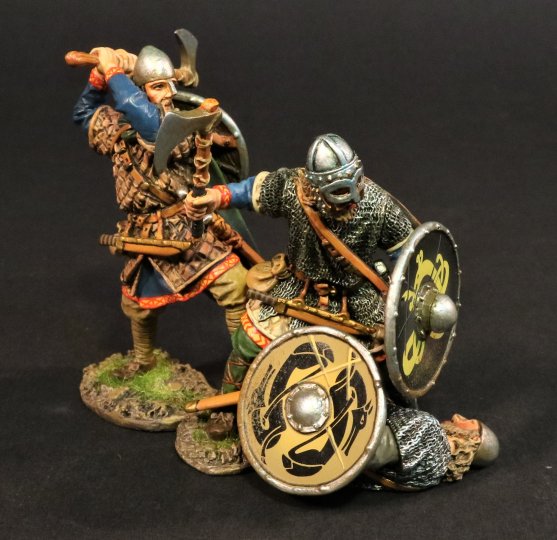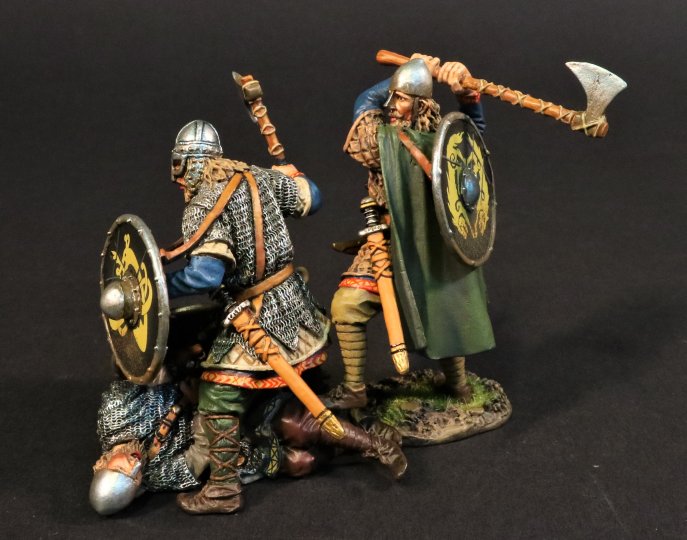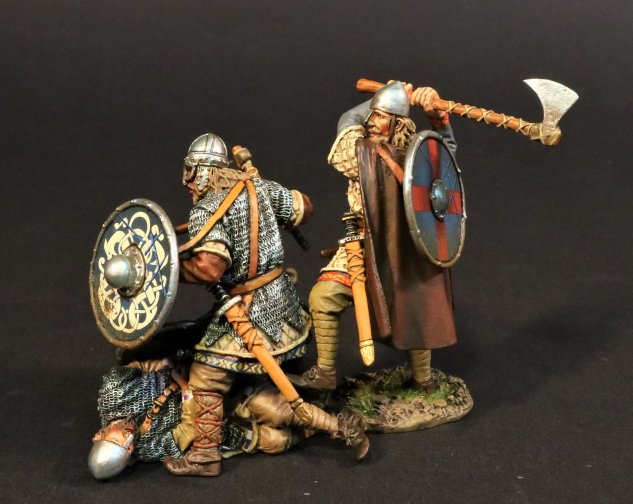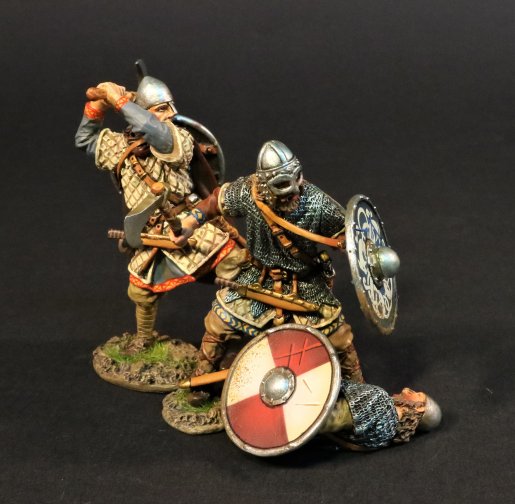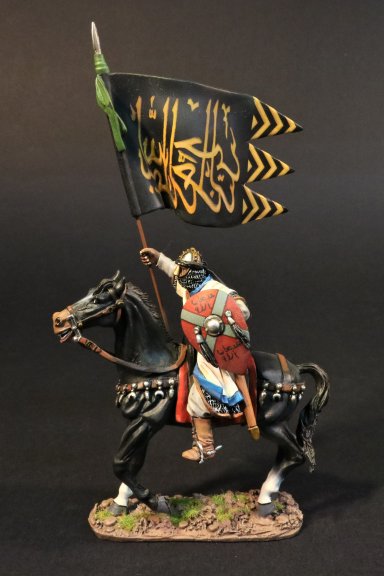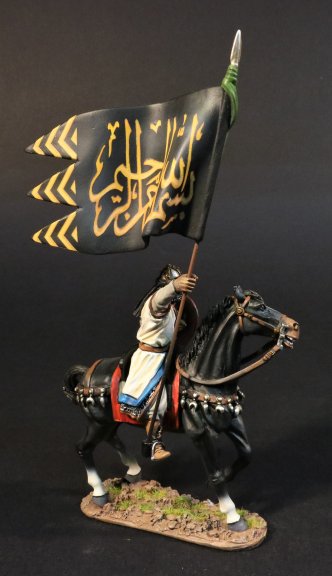- Joined
- Feb 2, 2011
- Messages
- 2,093
NEW RELEASES FOR FEBRUARY 2022
THE AGE OF ARTHUR
THE NORMAN ARMY
William Duke of Normandy (c. 1028-1087), usually known as William the Conqueror was the first Norman King of England, reigning from 1066 until his death in 1087.
In the 1050’s and early 1060’s, William became a contender for the throne of England held by the Childless Edward the Confessor, his first cousin removed.
There were other claimants. Including the powerful English earl Harold Godwinson, whom Edward had named as King on his deathbed, in January 1066.
William argued that Edward had previously promised the throne to him, and that Harold had sworn to support his claim.
Throughout the summer of 1066, William assembled an army and an invasion fleet in Normandy. This force included, in addition to troops from William’s own territories of Normandy and Maine, large numbers of mercenaries, allies and volunteers from Brittany, Northeast France and Flanders.
The Battle of Hastings took place on the 14[SUP]th[/SUP] October 1066. Although the numbers on each side were about equal, William had the advantage of having both cavalry, infantry and many archers.
Harold had only foot soldiers, and few archers. The English formed a shield wall along a ridge, and were initially so effective that the invading Norman army was repeatedly thrown back with heavy casualties.
Towards the end of the day some of William’s Breton troops panicked and fled, with some of the English troops pursuing the fleeing Bretons. These English troops who had broken ranks, were themselves attacked and destroyed by the Norman mounted knights.
Norman knights were armoured warriors that fought on horseback, with lance , sword and shield. These were the Norman “secret weapon” as nothing like them had been seen before in England. There were between 1,000-2,000 Norman knights in William’s army, and it was these troops which proved decisive to the invading army’s victory.
Two further Norman retreats were feigned, which once again drew the English into pursuit and expose them to repeated attacks by the Norman cavalry.
It appears that the decisive event was Harold’s death, of which there are differing versions which are told.
William of Jumieges claimed that Harold was killed by the Duke himself.
The Bayeux tapestry shows Harold’s death by an arrow to the eye.
We know that the English forces were deployed in a dense shieldwall formation at the top of a slope, (which newer sources suggests was Caldbec Hill), with their flanks protected by woods, and with marshy ground in front of them.
What is known about the Norman deployment, is that Duke William appears to have arranged his forces in 3 groups or “battles”. The left “battle” consisted mainly of Bretons, and was led by Alan The Red.
The Centre was held by the Normans, under direct command of the Duke, and the right was commanded by William Fitzosbern and Eustace II of Boulogne, and consisted of Frenchmen. and mercenaries from Picardy, Boulogne and Flanders.
The front lines of the invading force were made up of archers, with a secondary line of foot soldiers armed with spears and swords. The cavalry was held in reserve.
The Norman disposition of forces implies that the plan was to open the battle with archers, weakening the enemy with arrows, followed by infantry who would engage the shieldwall in close combat. The infantry would create openings in the English lines that would then be exploited by cavalry charges.
It is believed that the early barrage of arrows, probably had very little effect on the English shieldwall, due to the higher position of the English on the ridge.
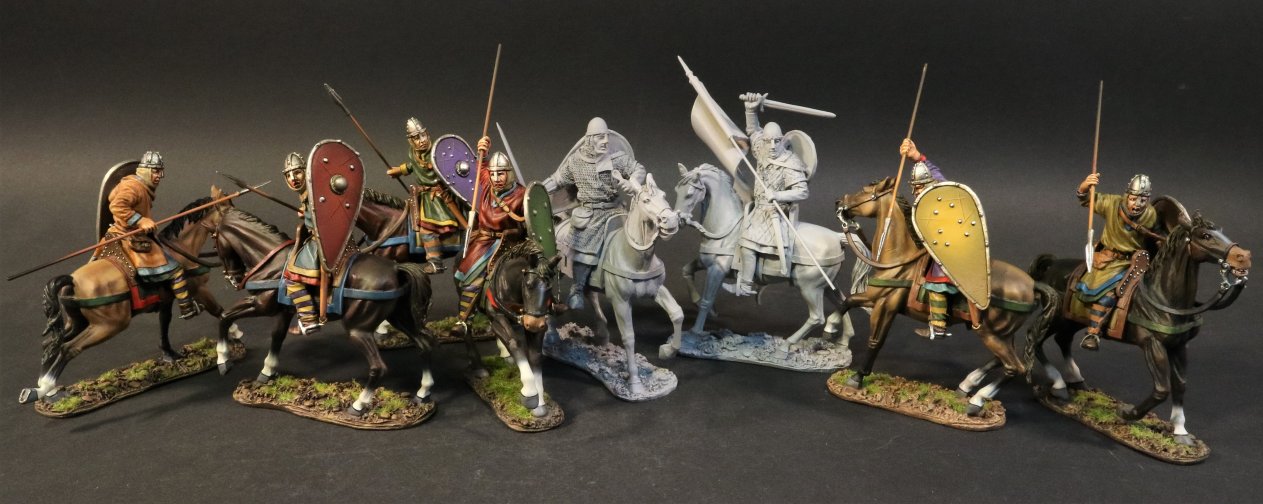
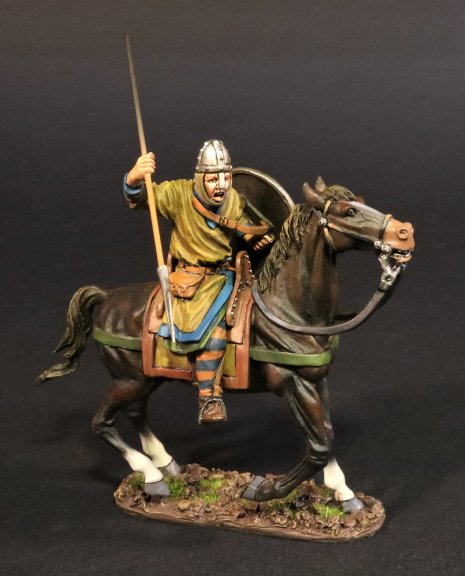
NM-55
THE AGE OF ARTHUR,
THE NORMAN ARMY,
BRETON CAVALRY.
(2 pcs)
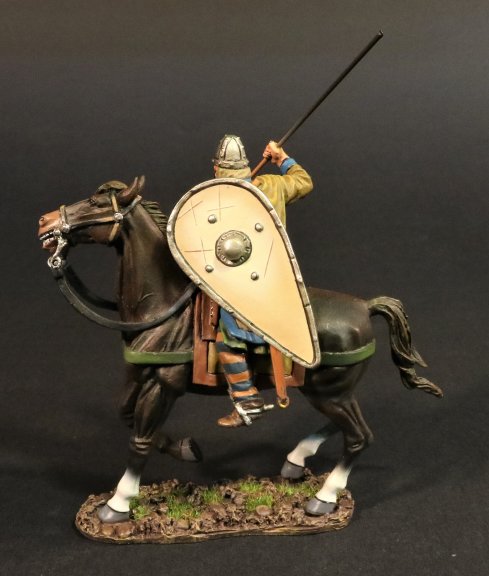
THE VIKINGS
THE VIKING “SHIELD WALL”
The formation of a shield wall (Skjaldborg in Old Norse) was a popular military tactic that was commonly used in many parts of Northern Europe, especially England and Scandinavia.
There were many slight variations of this tactic, but in general, a shield wall was a “wall of shields” formed by warriors standing in formation shoulder to shoulder, holding their shields so that they abut or overlap. Each warrior benefited from the protection of his neighbours’ shields as well as his own.
The shield-wall tactic suited inexperienced troops such as the English Fyrd or free peasant, as it did not require extraordinary skill, being essentially a shoving and fencing match with weapons.
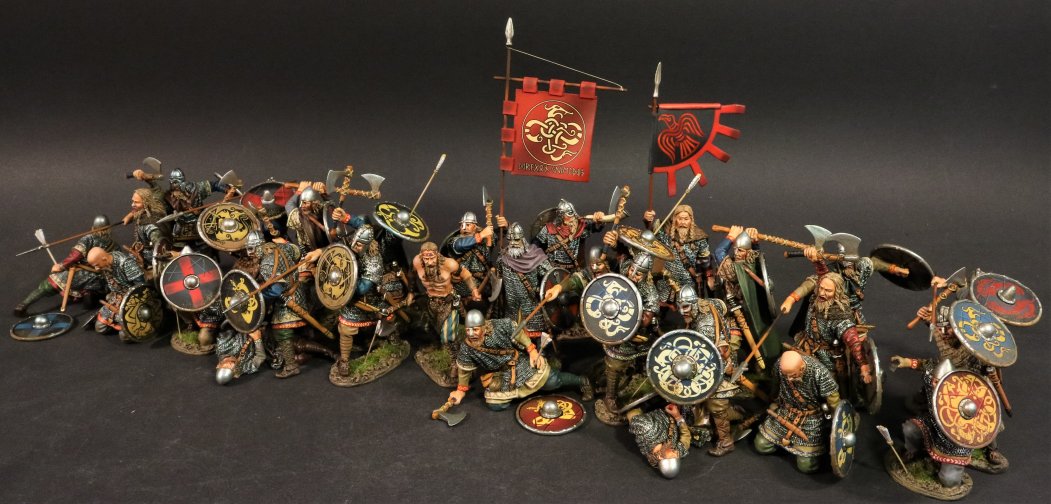
The first three ranks of the main wall would have been made up of select warriors, such as Huscarls and Thengs, who carried heavier weapons and wore armour. The vast majority of opponents were armed with spears, which they used against the unprotected legs or faces of their opponents. Often soldiers would use their weapons to support each other by stabbing and slashing to the left or the right, rather than just ahead. Short weapons such as the ubiquitous seax could also be used in the tight quarters of the wall.
The tactic was used at the Battle of Stamford Bridge, where the relatively well-armed Saxon army attacked the army of King Harald Sigurdsson of Norway. The Vikings were not wearing as much armour, having left their chain mail behind on the ships and wearing only their helmets, and after a bloody shield wall battle, they broke and fled in panic.
The drawback of the shield-wall tactic was that, once breached, the whole affair tended to fall apart rather quickly. Relatively lightly trained fyrdmen gained morale from being shoulder-to-shoulder with their comrades, but often fled once this was compromised. Once the wall was breached, it could prove difficult or impossible to re-establish a defensive line, and panic might well set in among the defenders.
Although the importance of cavalry in the Battle of Hastings saw the end of the shield wall tactic, massed shield walls would continue to be employed right up to the end of the 12[SUP]th[/SUP] Century, especially in areas that were unsuitable for large scale mounted warfare, such as Scandinavia, and Scotland.
In the late Middle Ages, the shield was abandoned in favour of polearms carried with both hands, giving rise to pike square tactics.
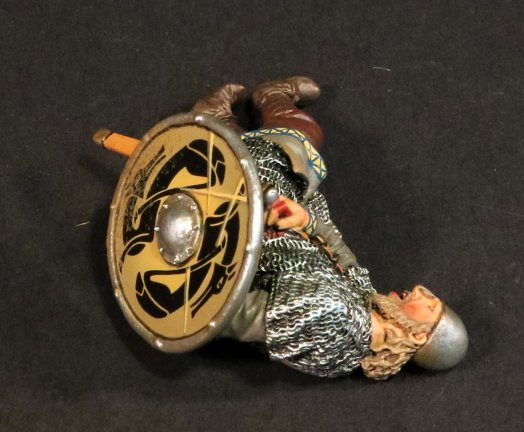
VIK-32A
THE AGE OF ARTHUR,
THE VIKINGS,
VIKING WARRIOR ,
(1 pc)
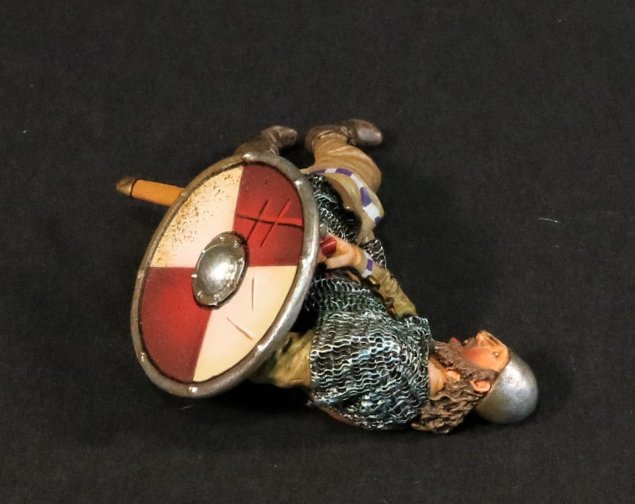
VIK-32B
THE AGE OF ARTHUR,
THE VIKINGS,
WOUNDED SAXON FYRDMAN,
(1 pc)
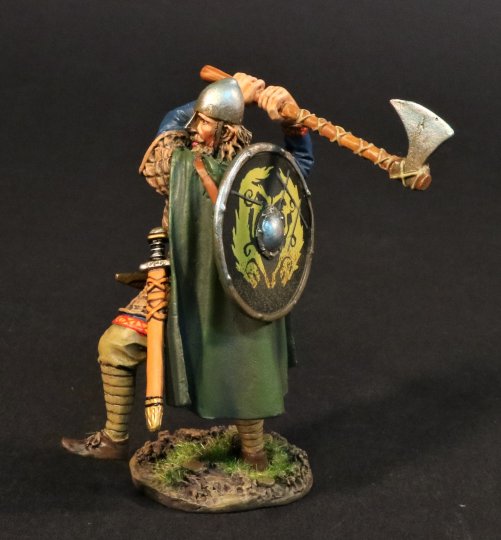
VIK-33A
THE AGE OF ARTHUR,
THE VIKINGS,
VIKING WARRIOR ,
(1 pc)
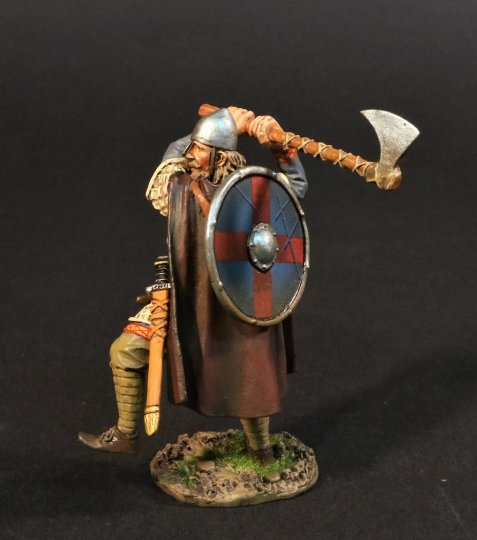
VIK-33B
THE AGE OF ARTHUR,
THE VIKINGS,
VIKING WARRIOR ,
(1 pc)
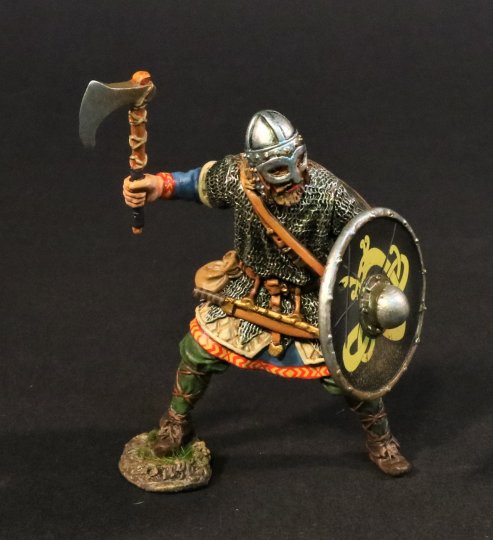
VIK-34A
THE AGE OF ARTHUR,
THE VIKINGS,
VIKING WARRIOR ,
(1 pc)
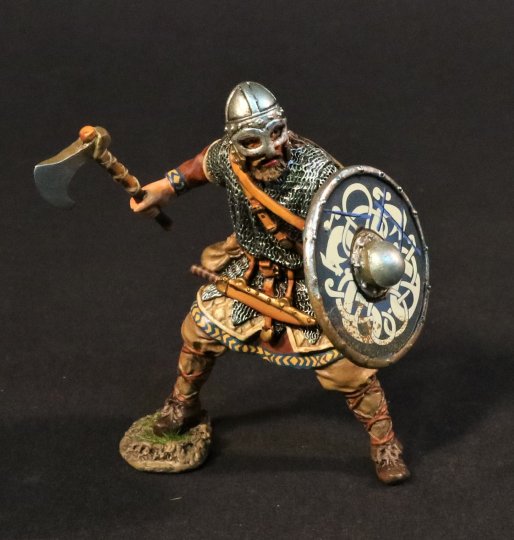
VIK-34B
THE AGE OF ARTHUR,
THE VIKINGS,
VIKING WARRIOR ,
(1 pc)
THE AGE OF ARTHUR
THE NORMAN ARMY
William Duke of Normandy (c. 1028-1087), usually known as William the Conqueror was the first Norman King of England, reigning from 1066 until his death in 1087.
In the 1050’s and early 1060’s, William became a contender for the throne of England held by the Childless Edward the Confessor, his first cousin removed.
There were other claimants. Including the powerful English earl Harold Godwinson, whom Edward had named as King on his deathbed, in January 1066.
William argued that Edward had previously promised the throne to him, and that Harold had sworn to support his claim.
Throughout the summer of 1066, William assembled an army and an invasion fleet in Normandy. This force included, in addition to troops from William’s own territories of Normandy and Maine, large numbers of mercenaries, allies and volunteers from Brittany, Northeast France and Flanders.
The Battle of Hastings took place on the 14[SUP]th[/SUP] October 1066. Although the numbers on each side were about equal, William had the advantage of having both cavalry, infantry and many archers.
Harold had only foot soldiers, and few archers. The English formed a shield wall along a ridge, and were initially so effective that the invading Norman army was repeatedly thrown back with heavy casualties.
Towards the end of the day some of William’s Breton troops panicked and fled, with some of the English troops pursuing the fleeing Bretons. These English troops who had broken ranks, were themselves attacked and destroyed by the Norman mounted knights.
Norman knights were armoured warriors that fought on horseback, with lance , sword and shield. These were the Norman “secret weapon” as nothing like them had been seen before in England. There were between 1,000-2,000 Norman knights in William’s army, and it was these troops which proved decisive to the invading army’s victory.
Two further Norman retreats were feigned, which once again drew the English into pursuit and expose them to repeated attacks by the Norman cavalry.
It appears that the decisive event was Harold’s death, of which there are differing versions which are told.
William of Jumieges claimed that Harold was killed by the Duke himself.
The Bayeux tapestry shows Harold’s death by an arrow to the eye.
We know that the English forces were deployed in a dense shieldwall formation at the top of a slope, (which newer sources suggests was Caldbec Hill), with their flanks protected by woods, and with marshy ground in front of them.
What is known about the Norman deployment, is that Duke William appears to have arranged his forces in 3 groups or “battles”. The left “battle” consisted mainly of Bretons, and was led by Alan The Red.
The Centre was held by the Normans, under direct command of the Duke, and the right was commanded by William Fitzosbern and Eustace II of Boulogne, and consisted of Frenchmen. and mercenaries from Picardy, Boulogne and Flanders.
The front lines of the invading force were made up of archers, with a secondary line of foot soldiers armed with spears and swords. The cavalry was held in reserve.
The Norman disposition of forces implies that the plan was to open the battle with archers, weakening the enemy with arrows, followed by infantry who would engage the shieldwall in close combat. The infantry would create openings in the English lines that would then be exploited by cavalry charges.
It is believed that the early barrage of arrows, probably had very little effect on the English shieldwall, due to the higher position of the English on the ridge.


NM-55
THE AGE OF ARTHUR,
THE NORMAN ARMY,
BRETON CAVALRY.
(2 pcs)

THE VIKINGS
THE VIKING “SHIELD WALL”
The formation of a shield wall (Skjaldborg in Old Norse) was a popular military tactic that was commonly used in many parts of Northern Europe, especially England and Scandinavia.
There were many slight variations of this tactic, but in general, a shield wall was a “wall of shields” formed by warriors standing in formation shoulder to shoulder, holding their shields so that they abut or overlap. Each warrior benefited from the protection of his neighbours’ shields as well as his own.
The shield-wall tactic suited inexperienced troops such as the English Fyrd or free peasant, as it did not require extraordinary skill, being essentially a shoving and fencing match with weapons.

The first three ranks of the main wall would have been made up of select warriors, such as Huscarls and Thengs, who carried heavier weapons and wore armour. The vast majority of opponents were armed with spears, which they used against the unprotected legs or faces of their opponents. Often soldiers would use their weapons to support each other by stabbing and slashing to the left or the right, rather than just ahead. Short weapons such as the ubiquitous seax could also be used in the tight quarters of the wall.
The tactic was used at the Battle of Stamford Bridge, where the relatively well-armed Saxon army attacked the army of King Harald Sigurdsson of Norway. The Vikings were not wearing as much armour, having left their chain mail behind on the ships and wearing only their helmets, and after a bloody shield wall battle, they broke and fled in panic.
The drawback of the shield-wall tactic was that, once breached, the whole affair tended to fall apart rather quickly. Relatively lightly trained fyrdmen gained morale from being shoulder-to-shoulder with their comrades, but often fled once this was compromised. Once the wall was breached, it could prove difficult or impossible to re-establish a defensive line, and panic might well set in among the defenders.
Although the importance of cavalry in the Battle of Hastings saw the end of the shield wall tactic, massed shield walls would continue to be employed right up to the end of the 12[SUP]th[/SUP] Century, especially in areas that were unsuitable for large scale mounted warfare, such as Scandinavia, and Scotland.
In the late Middle Ages, the shield was abandoned in favour of polearms carried with both hands, giving rise to pike square tactics.

VIK-32A
THE AGE OF ARTHUR,
THE VIKINGS,
VIKING WARRIOR ,
(1 pc)

VIK-32B
THE AGE OF ARTHUR,
THE VIKINGS,
WOUNDED SAXON FYRDMAN,
(1 pc)

VIK-33A
THE AGE OF ARTHUR,
THE VIKINGS,
VIKING WARRIOR ,
(1 pc)

VIK-33B
THE AGE OF ARTHUR,
THE VIKINGS,
VIKING WARRIOR ,
(1 pc)

VIK-34A
THE AGE OF ARTHUR,
THE VIKINGS,
VIKING WARRIOR ,
(1 pc)

VIK-34B
THE AGE OF ARTHUR,
THE VIKINGS,
VIKING WARRIOR ,
(1 pc)


